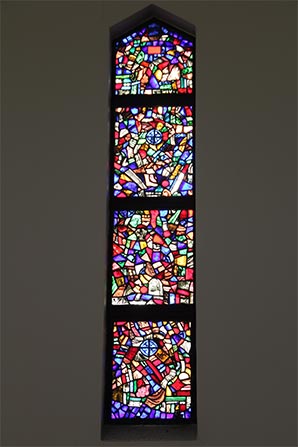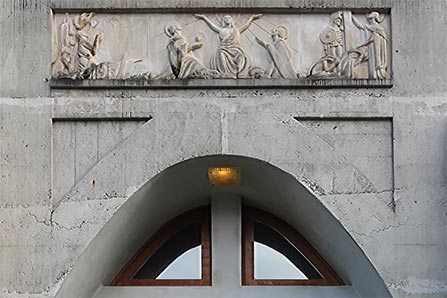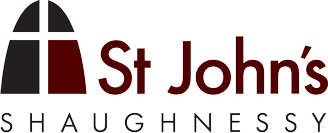 St. John’s has a wonderful history of committed faith to Christ’s gospel and it has played out in a variety of ways.
St. John’s has a wonderful history of committed faith to Christ’s gospel and it has played out in a variety of ways.
In 1910, Bishop Adam Urias de Pencier built See House at 1426 Nanton Avenue, converting a room in the basement to a chapel. When numbers increased in 1925, he encouraged the building of the first church on the site.
The present church was designed by Major G. L. Thornton Sharp in Art Deco style, and built in 1949 as a memorial church “…that it be a joyful song unto the Lord; and that it stand as a memorial honouring all Vancouver’s sons and daughters who answer the call to serve their country.” Funds for the project were raised from all over the Lower Mainland, some coming from outside the Anglican community, but nevertheless bonded by a common desire to build a living memorial.
The cornerstone was laid by J.E. McMullen K. C., in May 1949, and dedicated on June 18, 1950. Using an innovative building design, the church has stood proudly facing out on Granville Street, one of the main arteries of the city, as a symbol of the centrality of God in our community for the past 65 years.
 In addition to the magnificent lunette-shaped Memorial window that dominates the south side of the church, the Sanctuary Memorial windows are made of 11th century glass fragments from Canterbury Cathedral that were shattered during the bombing raids of World War II. There are numerous other stunningly beautiful memorial windows throughout the church, side chapels, and in the choir loft.
In addition to the magnificent lunette-shaped Memorial window that dominates the south side of the church, the Sanctuary Memorial windows are made of 11th century glass fragments from Canterbury Cathedral that were shattered during the bombing raids of World War II. There are numerous other stunningly beautiful memorial windows throughout the church, side chapels, and in the choir loft.
The church also has a number of very fine carvings. In particular, the pulpit is made of mahogany and yellow cedar, fronted by a black walnut cross. It is decorated by a wooden frieze of BC Dogwood flowers and Arbutus leaves. The two wooden figures sitting on top of the arms of the cross represent St. Michael and St. George. On the opposite side of the chancel, the lectern is also made of mahogany and yellow cedar. The angel of St John is painted on the frontal. A carved yellow cedar eagle, the symbol of St. John, with wings outstretched, supports the bible. On either side of the eagle are two insets, one of which contains a winged ox, the symbol of St. Luke, the other, a winged lion, the symbol of St. Mark.
The wooden pews date to the time the church was built. The beautiful, hand-painted flowers on yellow cedar panels at the end of each pew are the work of Barbara Sharp of Crofton B.C., the daughter of the architect who designed the church.
 The main organ was commissioned for the church and built by Hallman Organ Company of Kitchener ON. It has four manuals and six divisions, with sixty-six ranks. The 3,000 organ pipes came from Germany and Holland. There is a separate organ with 700 pipes in the gallery with its own console. The special feature of the principal instrument is the copper State Trumpets, located over the entrance from the narthex. Click this link for an interesting story about the SJS organ.
The main organ was commissioned for the church and built by Hallman Organ Company of Kitchener ON. It has four manuals and six divisions, with sixty-six ranks. The 3,000 organ pipes came from Germany and Holland. There is a separate organ with 700 pipes in the gallery with its own console. The special feature of the principal instrument is the copper State Trumpets, located over the entrance from the narthex. Click this link for an interesting story about the SJS organ.
St. John’s was one of the few modern Art Deco buildings on the City of Vancouver’s heritage inventory, but in 1990 it was in need of extensive repair and refurbishment. As part of the refurbishment, the sanctuary was redesigned to permit more natural light, the exterior was restored to its original condition, and provision was made for disabled access. Renovations have of course been ongoing and include removing the shutters from the front door allowing not only the light to come into the narthex, but also to allow us to welcome the world outside our front doors. The existing Cross, on the roof, was replaced, and we added flood lights to illuminate the front tower of the church as well as the Cross in 2014.
 There is a wonderful Art Deco frieze depicting three incidents in the life of St. John just above the main entrance of the church, facing Granville Street. In the centre is the risen Christ, with disciples John and James, sons of Zebedee, seated at his feet. On the left, John and James are by their boat mending their nets as they are been called by Christ. John is shown holding the Holy Grail. On the right, the three Marys are seen weeping at the foot of the cross with Roman guards. This frieze and the Bell Tower reliefs, representing the sculpted winged heart Sursum Corda meaning “lift up your hearts”, are the work of the late BC sculptor, Beatrice Lennie. The Administrative Building (formerly the Parish Hall) behind the church, that fronts onto Nanton Street. It was built between 1955-1956 and stands on the site of the See House and the original church parking lot. The Hall, along with the cloistered walkway that connects it to the church, were designed by Major G. L. Thornton Sharp, the same architect who did the church.
There is a wonderful Art Deco frieze depicting three incidents in the life of St. John just above the main entrance of the church, facing Granville Street. In the centre is the risen Christ, with disciples John and James, sons of Zebedee, seated at his feet. On the left, John and James are by their boat mending their nets as they are been called by Christ. John is shown holding the Holy Grail. On the right, the three Marys are seen weeping at the foot of the cross with Roman guards. This frieze and the Bell Tower reliefs, representing the sculpted winged heart Sursum Corda meaning “lift up your hearts”, are the work of the late BC sculptor, Beatrice Lennie. The Administrative Building (formerly the Parish Hall) behind the church, that fronts onto Nanton Street. It was built between 1955-1956 and stands on the site of the See House and the original church parking lot. The Hall, along with the cloistered walkway that connects it to the church, were designed by Major G. L. Thornton Sharp, the same architect who did the church.
In late 2014 the parish entered into a long-term lease for use of the Administration Building by the Diocese of New Westminster and the Anglican Archives of British Columbia. As a result, the Administration Building was completely refurbished from its roof to its boiler room to facilitate the work and many activities of the Diocese.


